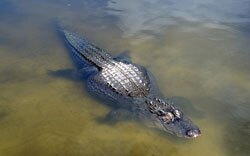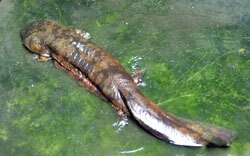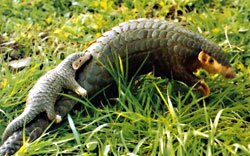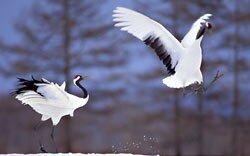Yangtze River Wildlife
The Yangtze River is one of the most well known rivers in the world and has a rich history and is of great importance to China's people. The longest river in Asia, it not only serves as a lifeline to millions of people, but also to some of the most unique and beautiful animals on this planet.
Beginning high in the Kunlun Mountains and running to just north of Shanghai where its mouth opens into the East China Sea, the river covers almost 4,000 miles and winds its way through 11 provinces. It is a region of extremes which boasts an array of wildlife. The waters sustain animal and plant life in a 3.7 million square mile area. Every sized creature, from the tiniest fish to providing life to the bamboo forests that feed the giant panda, finds something to benefit from the Yangtze.
Animals in the Water
While various birds, rodents, mammals and amphibians flock to the waters for food, it is the animals within the waters that capture the attention and imagination of millions.
There are over 350 species of fish that make their home in the rich waters of the Yangtze. More populated species, such as the yellow head catfish and the carp, are also important to the ecosystem and the food chain. Copper fish, Chinese shad, eel and anchovy are also quite common in the waters. The Chinese Puffer fish is also home in the Yangtze, as well as other Asian bodies of water. Its skin and reproductive organs are highly toxic and poisonous to humans.
Chinese Alligator
 The Chinese alligator is the only known living species of alligator native to China. It makes its home exclusively in The Yangtze River and the surrounding ponds in the river's lower regions. Although it is very similar in appearance to the American alligator, the Chinese alligator is much smaller than its counterparts, usually reaching just 1.5 meters (5 feet) in length and weighing around 45 kilograms (100 pounds).
The Chinese alligator is the only known living species of alligator native to China. It makes its home exclusively in The Yangtze River and the surrounding ponds in the river's lower regions. Although it is very similar in appearance to the American alligator, the Chinese alligator is much smaller than its counterparts, usually reaching just 1.5 meters (5 feet) in length and weighing around 45 kilograms (100 pounds).
With only around 200 individuals accounted for in the wild, the Chinese alligator is listed as a critically endangered species. Currently, conservation efforts are being made to the re-populate the species in wild habitats, as well as protecting the alligator with strict restraints on trade and exportation worldwide.
Yangtze River Dolphin
 The freshwater Finless Porpoise,which is also known as Yangtze River Dolphine, also makes it home in the shallower waters of the Yangtze. Missing its dorsal fin, the people of China aptly have named it the 'river pig'. The Finless Porpoise is also in danger of becoming extinct. Only around 800 of the animals remain in the river, and that number is rapidly dropping. But just like the Chinese alligator, efforts are being made to decrease sand dredging, which muddies the lakes and disturbs the porpoise's habitat.
The freshwater Finless Porpoise,which is also known as Yangtze River Dolphine, also makes it home in the shallower waters of the Yangtze. Missing its dorsal fin, the people of China aptly have named it the 'river pig'. The Finless Porpoise is also in danger of becoming extinct. Only around 800 of the animals remain in the river, and that number is rapidly dropping. But just like the Chinese alligator, efforts are being made to decrease sand dredging, which muddies the lakes and disturbs the porpoise's habitat.
Yangtze Giant Softshell Turtle
 Another extremely rare animal is The Yangtze River Giant Softshell Turtle. Once thriving in its native waters, as little as four individuals are known to remain. The soft-shell turtle looks a bit different from its hard-shell counterparts. It is known for its deep head and pig-like snout, as well as a smooth, non-scaly, leathery shell. This feature allows the turtle to move more easily in muddy lakes and river bottoms.
Another extremely rare animal is The Yangtze River Giant Softshell Turtle. Once thriving in its native waters, as little as four individuals are known to remain. The soft-shell turtle looks a bit different from its hard-shell counterparts. It is known for its deep head and pig-like snout, as well as a smooth, non-scaly, leathery shell. This feature allows the turtle to move more easily in muddy lakes and river bottoms.
Chinese Giant Salamander
 The clearer, fast running waters of the Yangtze support the curious Chinese Giant Salamander. It prefers dim, rocky mountain streams, and has been over hunted for its use in tradition Chinese medicines. Dark dwelling places have left them nearly blind. They relies on sensory nodes to detect their prey. While most are not quite as large as the name would imply, some reach up to 1.8 meters (5.9 feet).
The clearer, fast running waters of the Yangtze support the curious Chinese Giant Salamander. It prefers dim, rocky mountain streams, and has been over hunted for its use in tradition Chinese medicines. Dark dwelling places have left them nearly blind. They relies on sensory nodes to detect their prey. While most are not quite as large as the name would imply, some reach up to 1.8 meters (5.9 feet).
The Chinese Paddlefish
 The Chinese Paddlefish is the one of the largest fresh water fish in the world. An individual animal can reach lengths of up to 2 meters (6.5 feet) and weigh around 25 kilograms (55 pounds), and is equipped with a long paddle-like snout to stir up the bottom while looking for food. Poetically referred to as the "Giant Panda of the River", these massive swordfish-like creatures are critically endangered, threatened by dams, which divide and isolate groups. Last confirmed living fish was sighted in early 2003 The Yangtze River.
The Chinese Paddlefish is the one of the largest fresh water fish in the world. An individual animal can reach lengths of up to 2 meters (6.5 feet) and weigh around 25 kilograms (55 pounds), and is equipped with a long paddle-like snout to stir up the bottom while looking for food. Poetically referred to as the "Giant Panda of the River", these massive swordfish-like creatures are critically endangered, threatened by dams, which divide and isolate groups. Last confirmed living fish was sighted in early 2003 The Yangtze River.
Yangtze Sturgeon
Named a 'national treasure' by the Chinese government, the Yangtze Sturgeon, also known as Dabry's Sturgeon, is truly a living fossil. Thought to have lived amongst the dinosaurs, this bony river fish spends its life in both fresh and salt water, much like the salmon. The sturgeon migrates upstream to reproduce in the Yangtze's fresh waters. Its existence is also threatened by pollution and other harmful acts by man. A recent re-population program by the Chinese Academy of Fisheries Sciences has bred the species in captivity in hopes of restoring the river's population before it is lost forever.
Creatures around the Yangtze
While cruising on the river, it is amazing to see just how many species find life in and around the Yangtze. Look up into the trees and see a whole different kind of animal activity than that below the surface. The adorable Red Panda is home here and found only in the foliage forests of eastern China and Nepal. The small, rust colored creature resembles more a raccoon than a panda. The coloring helps the animal blend in with the red mosses and white lichens in its habitat.
Red-and-White Flying Squirrel
 Another tree dwelling species, the Red-and-White Flying Squirrel, makes it's home above the Yangtze. Similar in color to the Red Panda, the flying squirrel doesn't actually fly from branch to branch, but rather uses a skin flap between the front and hind legs to catch wind and glide long distances between trees.
Another tree dwelling species, the Red-and-White Flying Squirrel, makes it's home above the Yangtze. Similar in color to the Red Panda, the flying squirrel doesn't actually fly from branch to branch, but rather uses a skin flap between the front and hind legs to catch wind and glide long distances between trees.
The Pangolin
 The pangolin, a unique nocturnal animal, can also be found around The Yangtze River. It is also known as the scaly anteater, and while active at night, it spends most of the day rolled up in a ball, sleeping. While it poses virtually no threat to humans, the pangolins are skilled at climbing and their scales can be razor sharp.
The pangolin, a unique nocturnal animal, can also be found around The Yangtze River. It is also known as the scaly anteater, and while active at night, it spends most of the day rolled up in a ball, sleeping. While it poses virtually no threat to humans, the pangolins are skilled at climbing and their scales can be razor sharp.
Chinese Golden Monkey
 The Chinese Golden Monkey is home in the depths of the fir forests and in the snow covered mountains of the Yunnan-Tibetan areas, which are, of course, supported by the rich Yangtze River. Cute faced and small in stature, the monkeys are recognizable by their unique light colored gold faces. They share their habitat with others, often living in family groups, and have been known to live in herds of over 600 individuals. Living quite high above sea level, they share an ecosystem with the giant panda.
The Chinese Golden Monkey is home in the depths of the fir forests and in the snow covered mountains of the Yunnan-Tibetan areas, which are, of course, supported by the rich Yangtze River. Cute faced and small in stature, the monkeys are recognizable by their unique light colored gold faces. They share their habitat with others, often living in family groups, and have been known to live in herds of over 600 individuals. Living quite high above sea level, they share an ecosystem with the giant panda.
Chinese Golden Swallow
Unique and varied species of birds also nest around the Yangtze waters. The Golden Swallow, a short-beaked bird which nests in caves and rock structures is often made into soups and delicacies. The Golden Pheasant, or the Chinese Pheasant, also lives in the native forests around the Yangtze. They feed on the ground and prefer running to flying, but do roost in trees at night. The males of the species are brightly colored from head to toe, and while hard to spot in the wild, are found at most zoos and reserves. The Chinese Grouse, very similar to the Hazel Grouse, is a sedentary bird native to the mixed forests of central China.
The Golden Eagle
The birds around the Yangtze aren't limited to small, insect feeding species. The Golden Eagle, one of the best known birds of prey in the Northern Hemisphere, might also be spotted along the river banks. They make great use of their agility, speed and powerful talons when hunting down small and large rodents and mammals. They have even been known to attack deer and hunt and kill wolves, so as you can imagine, their status is highly regarded in China and around the world. It gets its name from the lighter, gold colored plumage around their necks and heads. It gives the birds the illusion of a golden glow.
The Siberian Crane
 The eastern populations of the Siberian Crane, a beautiful and elegant creature, escape the harshness of the Arctic tundra and fly in mass numbers to Poyang Lake. This body of water is closely associated with the Yangtze. The Three Gorges Dam, a massive hydroelectric dam that spans the Yangtze River has caused significant ecological changes and altered water routes which might disturb the migration of the Siberian Crane, as well as have impact on countless other species. These beautiful birds are characterized by their stark white coloring, in contrast to the black primary feathers are seen only while flying, and their naked red face. While only around 3000 still remain in the wild, thousands of those migrate yearly to China to winter.
The eastern populations of the Siberian Crane, a beautiful and elegant creature, escape the harshness of the Arctic tundra and fly in mass numbers to Poyang Lake. This body of water is closely associated with the Yangtze. The Three Gorges Dam, a massive hydroelectric dam that spans the Yangtze River has caused significant ecological changes and altered water routes which might disturb the migration of the Siberian Crane, as well as have impact on countless other species. These beautiful birds are characterized by their stark white coloring, in contrast to the black primary feathers are seen only while flying, and their naked red face. While only around 3000 still remain in the wild, thousands of those migrate yearly to China to winter.
Large Species in the Forests near the Yangtze
Large, well-known and elusive species also lurk in the forests sustained by the Yangtze.
Tibetan Antelope
 Up in the Tibetan plateau, in Quinghai province and in the Xinjiang Autonomous Region, roams the Tibetan Antelope, also sometimes referred to as the Chiru. It is a medium sized animal with a grey to reddish-brown coat and a white underbelly. There are currently less than 75,000 animals remaining in the wild. The Chiru's wool is soft and fine, and while it can be obtained without killing the animal, many poachers don't take this humane approach. Without the Yangtze, these herds would not have sufficient water and food supplies to last.
Up in the Tibetan plateau, in Quinghai province and in the Xinjiang Autonomous Region, roams the Tibetan Antelope, also sometimes referred to as the Chiru. It is a medium sized animal with a grey to reddish-brown coat and a white underbelly. There are currently less than 75,000 animals remaining in the wild. The Chiru's wool is soft and fine, and while it can be obtained without killing the animal, many poachers don't take this humane approach. Without the Yangtze, these herds would not have sufficient water and food supplies to last.
Mongolian gazelle
 The Mongolian gazelle is also sometimes referred to as Zeren. This medium-sized antelope is native to the Asian steppes in Mongolia, but can also be found in China. Look for the distinctive heart-shaped patch on their rears and their light brown coat. While they prefer to stay in smaller groups, massive herds of over 5,000 members are not unheard of.
The Mongolian gazelle is also sometimes referred to as Zeren. This medium-sized antelope is native to the Asian steppes in Mongolia, but can also be found in China. Look for the distinctive heart-shaped patch on their rears and their light brown coat. While they prefer to stay in smaller groups, massive herds of over 5,000 members are not unheard of.
The Wolf
 Man's best friend first appeared around the waters of the Yangtze over 16,000 years ago. Today, its ancestor, the wolf, can still be spotted in some regions of China. Isolated pockets of the grey wolf are scattered around the southwestern and northern regions of the country. Like other animals in the area, the wolf is also in danger of becoming extinct. They used to thrive in central China, but numbers have now dwindled due to environmental disturbances.
Man's best friend first appeared around the waters of the Yangtze over 16,000 years ago. Today, its ancestor, the wolf, can still be spotted in some regions of China. Isolated pockets of the grey wolf are scattered around the southwestern and northern regions of the country. Like other animals in the area, the wolf is also in danger of becoming extinct. They used to thrive in central China, but numbers have now dwindled due to environmental disturbances.
Snow Leopard
 The elusive Snow Leopard also inhabits the Yangtze Basin. Large and heavy-bodied, this beautiful creature prefers to spend most of its time in the rocky Himalayan foothills. It sports a thick smoky gray or tan coat with black rosette spots covering the back and face of the animal. Their paws are wide and tails long and thick, which help them to maintain balance on rocky cliff sides. For hunting purposes, the Snow Leopard descends into the Yangtze Basin for better prey. With less than 5,000 in the wild, the leopard is a rare, albeit magnificent, sight.
The elusive Snow Leopard also inhabits the Yangtze Basin. Large and heavy-bodied, this beautiful creature prefers to spend most of its time in the rocky Himalayan foothills. It sports a thick smoky gray or tan coat with black rosette spots covering the back and face of the animal. Their paws are wide and tails long and thick, which help them to maintain balance on rocky cliff sides. For hunting purposes, the Snow Leopard descends into the Yangtze Basin for better prey. With less than 5,000 in the wild, the leopard is a rare, albeit magnificent, sight.
Giant Panda
 The Giant Panda, the most recognizable animal from China, makes it home in the central western and southwestern regions of the country. Although officially classified as a carnivore, the animal's diet consists of 99% bamboo. The amount of bamboo needed to sustain just one animal is outstanding. An adult panda will eat anywhere from 9 to 14 kilograms of bamboo shoots a day. Only a river as large as the Yangtze could support an ecosystem that feeds giant species such as the panda. In China's past, pandas were thought to be rare and kingly creatures. Unlike other animals, pandas were rarely thought to have medical uses. Today, the giant panda is among the world's most adored and protected animals, especially in China, where its image is stamped on a large number of commemorative coins. Its lovable nature is why wide-scale efforts have been made to protect the panda's habitat. A depletion of its ecosystem, coupled with a very low birthrate, has labeled the pandas an endangered species.
The Giant Panda, the most recognizable animal from China, makes it home in the central western and southwestern regions of the country. Although officially classified as a carnivore, the animal's diet consists of 99% bamboo. The amount of bamboo needed to sustain just one animal is outstanding. An adult panda will eat anywhere from 9 to 14 kilograms of bamboo shoots a day. Only a river as large as the Yangtze could support an ecosystem that feeds giant species such as the panda. In China's past, pandas were thought to be rare and kingly creatures. Unlike other animals, pandas were rarely thought to have medical uses. Today, the giant panda is among the world's most adored and protected animals, especially in China, where its image is stamped on a large number of commemorative coins. Its lovable nature is why wide-scale efforts have been made to protect the panda's habitat. A depletion of its ecosystem, coupled with a very low birthrate, has labeled the pandas an endangered species.
Current Situation of Animals in and around the Yangtze
Because of its commercial use, along with tourism and pollution, the Yangtze has had more species become extinct than any other river in the world. While efforts are being made to restore the habitat for many animals, there is no telling how long the river's waters will sustain some of the precious life within. Beautiful waters, unique rock formations, winding waterways and an ancient history draw tourists from all over the world. It is no wonder that The Yangtze River is highly regarded and revered by all who visit.



